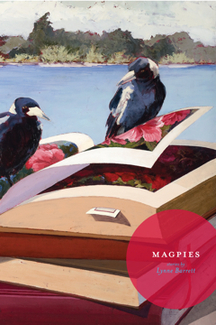On Magpies: Part Two of a Four-Part Interview with Lynne Barrett

If you missed Part One of my interview with Lynne Barrett, you can find it here.
If you want to meet Lynne, she will be reading from and discussing Magpies at the Miami Book Fair as part of a panel with Tayari Jones (Silver Sparrow), Ana Menendez (Adios, Happy Homeland) and Justin Torres (We The Animals) on Sunday, Nov. 20, 12:30 p.m., in Room 3209, (Building 3, Second Floor), Miami Dade College, Wolfson Campus.
And now, Part Two of our interview:
Angela: Many of the stories in Magpies are set in Florida—how important is place in your writing? Do you see setting as merely a backdrop for character and plot or as something more important? Do you visit the places you write about, taking notes, or do you write from memory and imagination?
Lynne: I don’t think of it as backdrop—it’s much more three-dimensional than that. I’m very aware of the space characters move through, what can be seen from where, and how the sensory elements of a place affect those who are in it. In a story like “One Hippopotamus,” which takes place during one night, with a couple in bed talking when the electricity has gone out (hmm, there’s electricity again!), we can see only what the narrator sees, in flashes of lightning, but sounds, smells, and her spatial knowledge of her tiny house, are all used so that we feel the structure around them, and beyond that the storms moving over it.
Anywhere I go, I think I observe places, letting them sink in, and seeing what resonates later. So that’s another bit of the Magpie in me. I invented sinkholes (ancient and new) for the story “When, He Wondered.” I’ve seen real ones, but I also did research, including speaking with someone who had done diving in the kind of underwater river that’s in the story. I think we should always feel that this particular story could only happen in this particular way in this particular place (even it its an imaginary place). It matters what the weather is, the time of day. It matters that when Tom in “When, He Wondered” goes to the driving range with his old friend, it’s around sundown, and he can see their elongated shadows competing, just as it matters how hot and sunny it was it was when they first discovered the underground river as boys.
Angela: You write across genres—there are elements of crime, fantasy, relationship-based fiction in this collection and even in individual stories—do you think about genre conventions as you write or does the story drive the process?
Lynne: Certainly I’m aware of conventions, but I don’t view them as walled-off from each other or constricting. Anything is fair to use as long as you do it well. That said, character most drives my choices. So in “Gossip and Toad” I wanted to write about a professional gossip who has come to that work through a natural inclination to say stinging things, and I felt her professional nastiness should have unanticipated consequences. Some of these consequences could be in a purely realist story, but I borrowed one from the fairy-tale “Diamonds and Toads,” where an evil character speaks and spiders and toads come out of her mouth. I guess this could be called fantasy, but it is so much a way of making an element of character visible, I think of it as like something in Ovid, mythic, the psychological externalized. And then I played with it as if it were absolutely real. If I had to label the story, I’d say it was magical realism, which is a wonderful oxymoron that covers a lot of possibilities.
Tomorrow, Part 3, from the Empress of Plot.





1 Comment
wholly jeanne
Angela, you ask such thoughtful questions – not the usual interview questions. Lynne, love the term “magical realism” – a delightful oxymoron.